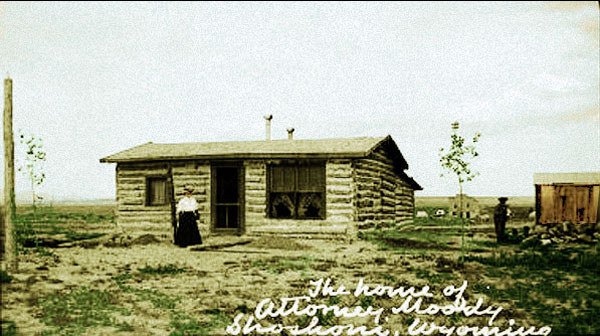
Town Attorney Warner Moody residence, 1906.
In July 1906, Shoshoni received national publicity, not necessarily the type which would attract settlers. As noted by Professor Larson, History of Wyoming, 2nd Ed. Revised, p. 351, the publicity made
Shoshoni as "somewhat reminiscent of Union Pacific hell-on-wheels communities of an earlir generation."
On July 20, 1906, Mr. and Mrs. Robert H. Knettle hosted a dance at their residence. Among those attending was the
town attorney Warner Moody and his wfe. Moody was the son of the late United States senator of South Dakota Gideon C. Moody.
Warner Moody had grown up in Deadwood and attended Yale, Class of 1900. Following graduation, he returned to Deadwood and read law in his father's law office.
In 1904, he father died. Warner Moody then moved from Deadwood to Casper and thence in 1905 to Shoshoni.
Mrs. Moody left the dance before her husband. Moody left the dance about midnight. As he reached his house, he was bushwhacked with two shots.
A neighbor, Frank Anderson, heard the shots. Anderson resided in a nearby tent. Andeston stepped to the door of his tent and saw
three men. One ran toward the railroad tracks, the other two in the opposite direction. Anderson gave chase to the one, who turned and shot
Anderson. At first it was thought that Anderson would not survive. About nine hours later, boodhounds were brought out to
following the one along the road beside the tracks. The bloodhounds, however, in the heat of the day, lost their sense of scent.
At first, the shooting was blamed on men who were running the gambling dens with which Shoshoni was rife. It was believed to have been as a result of the efforts of
Mr. Moody to close down the dens. Midst threats to lynch the gamblers, Mayor Quintrell wired governor B. B. Brooks for help. Governor Brooks dispatched a
unit from Douglas to Shoshoni by special train. Calm was restored. Then the attention was taken off the gambling lairs and focused on
cavalrymen stationed at Ft. Washakie. It was contended that two military shells were found near the scene of the crime and they matched the bullets in
Moody's body. Next, it was announced that the crime was committed by an enemy of Moody from Deadwood. Word was received that
Deputy United States Marshal Joe Lefors was hot on the trail. In September, the Deadwood Pioneer-Times reported that an unnamed source had quoted
Lefors as saying he knew who did it and within severa weeks an arrest would be made. Over one hundred years later, no arrest has been made and the culprit is still unknown.
Moody's funeral was held in Casper. His body was shipped to California where he was interred. On August 1, the Moody residence was sold to Henry Hey, the cashier of the
Wind River National Bank. The gambling in Shoshoni continued.
Following the arrival of the Railroad, in addition to the plethora of saloons and "thirst parlors," Shoshoni had, according to
the Shoshoni Commercial Club, two general stores, two groceries, one hardware, one harness and saddlery, one drug store, a lumber yard,
a barber shop, meat market, three restuarants, two hotels, two rooming houses, three restaurants,and two blacksmiths and one livery barn.
The two hotels might not seem like much.
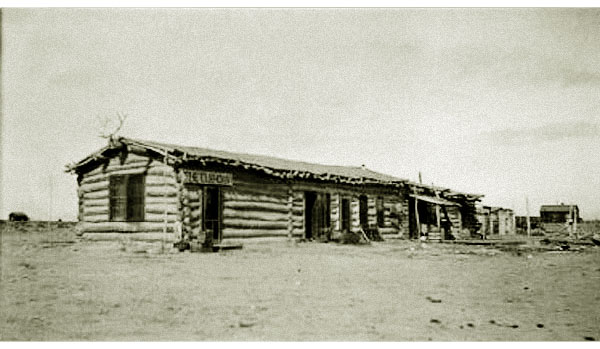
Elkhorn "Hotel," approx. 1906.
The Elkhorn advertised "Feed, Corral, Hay, Grain, Water;" "First Class Meals at popular prices; "bunk house in connection."
The Elkhorn was owned by Moses L. Bright (1833-1916). Bright was born in Kentucky. At age 17, he joined the '49ers and went to California. He returned to Middlebrook, Nebraska where he was a millwright.
With the opening of the Reservation came to Shoshoni where he constucted the Elkhorn. In 1912, he moved to Pinedale where in conjunction with his stepson operated a ranch. In 1816 at age 83 he decided to
move to Brown's Park, Colorado. On the way he became ill and died in the State Hospital at Rock Springs.
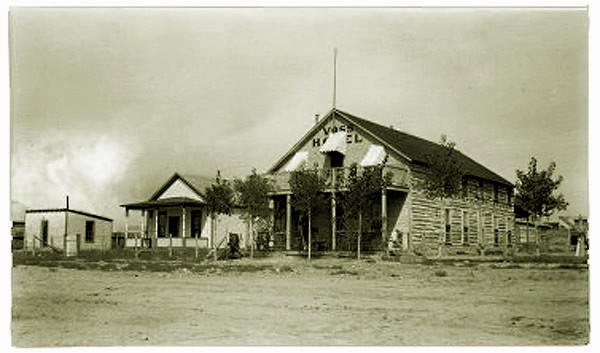
Voss Hotel" approx. 1906.
The Voss Hotel was constructed by John F. Voss. It bragged that it had 16 "first class" rooms, a parlor, dining room and a 16 X 18 foot kitchen.
Voss previously had the contract for the "Star Route" Thermopolis-Ft. Washakie Stage. For a 3 minute film explaining "Star Routes," see
National Postal Museum [linked]. In Shoshoni, Voss also ran the Star Livery and Feed Barn.
With the arrival of the railroad and C. H. King's lumberyard, other permanent buildings could be constructed. On the east side of Main Street a number of buildings were constructed.
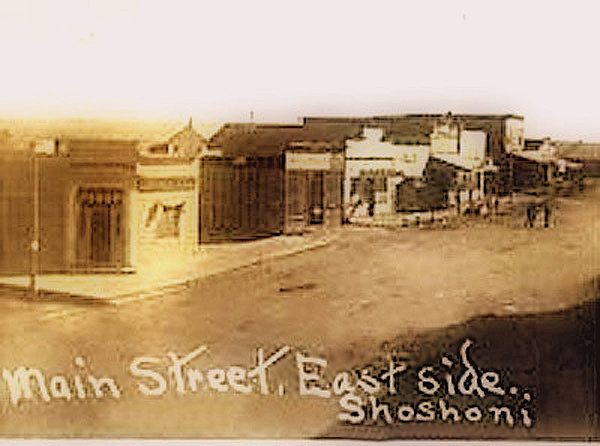
East Side of lower Main Street, Shoshoni, 1906.
The building on the corner of Second Street and Main is the Wind River National Bank is the Wind River National Bank established in 1906 by John Clay, Henry G. Hey, Jr. and A. H. Marble all important
investors in the Stockgrowers National Bank in Cheyenne. On March 16, 1908, in the early morning hours a fire started in Edward Burke's saloon. The fire spread. The entire block on the east side of Main Street between First Street and Second was
consumed by the flames. Destroyed were the Telephone Building, the Wind River National Bank,
the Davidson building, Williams' Saloon, Ed Burke's Saloon (formerly the Palace), Hargrove Pool Hall,
reamy Barber shop, Hotel Maria, Johnson's Saloon, H. D. Ballard's hide house and Ballard and Beck Restaurant. Many of the building were not reconstructed.
The Wind River National Bank was merged into the First National Bank of Riverton. Also consumed in the flames was the Famous Clothing store constructed in the vacant lot to the right of the bank after the above photo was taken
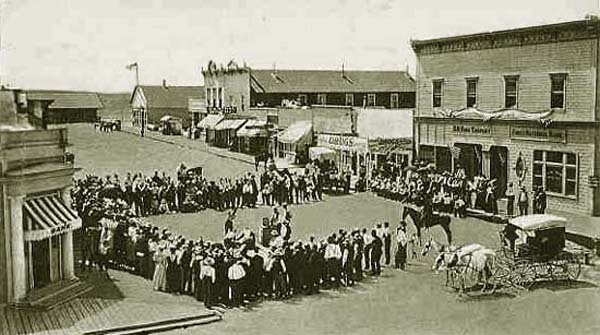
Rock Drilling Contest, Shoshoni, 1908
Across the street from the viewer on the right is
the C. H. King Company and the First National Bank of Shoshoni. The C. H. King Building was completed and the bank opened in
February 1906.
The siding on the C. H. King Building is pressed metal in a stone pattern. The building also featured pressed metal
facias. Separating the entrance of the bank from the entrance to the C. H. King Store was a pressed metal pilaster. The building is still in existence.
The upper floor was used as the Masonic Hall. It is on the National Register. Until comparitively recently the downstairs housed the Yellowstone Drugstore. The drugstore
was famed for its "real" milkshakes. Unfortunately, with a change of ownership of the building, the drugstore had to move to a new location at 502. E. 2nd Street. The new building was
a former fast foot cafe. It wasn't the same and closed. When the C. H. King Building housed the drugstore, it had been painted yellow.
The writer has not been the only one to go to the old building for an old fashioned "real" milkshake and be disappointed. As of 2013, the building has it windows covered with old newspapers and the bottom has been repainted.
Charles Henry King (1853-1930) was the paternal
grandfather of President Gerald Ford and previously operated merchantile businesses
in Fetterman City, Kaycee and Douglas. President Ford's mother divorced his father, Leslie L. King,
a wool dealer in Omaha, and
upon his mother's remarriage Ford adopted his stepfather's name.
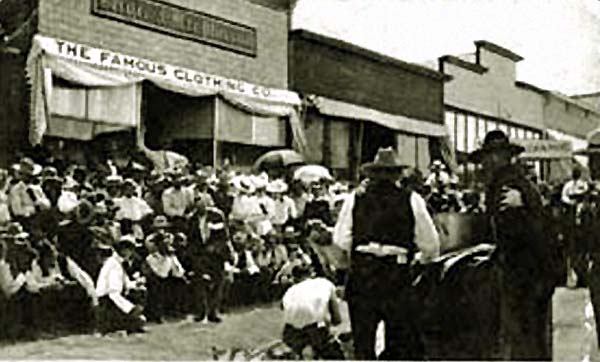
Another view of rock drilling contest, 1908
As previously noted, the building in the background were burned in 1908. Other buildings were constructed on the site of the buildings that had burned.
Most prominent were the Heyer & Berger Building constructed by Arnold Oliver Heyer (1877-1938) and the Shawver Hotel, jewelers and drugstore constructed on the
former site of the Wind River National Bank.
Heyer replaced R. H. Knittle when the later resigned. Heyer was active in the Republican Party and served as
an alternate delegate to the 1932 Republican Convention.

Heyer-Berger Building, approx. 1908.
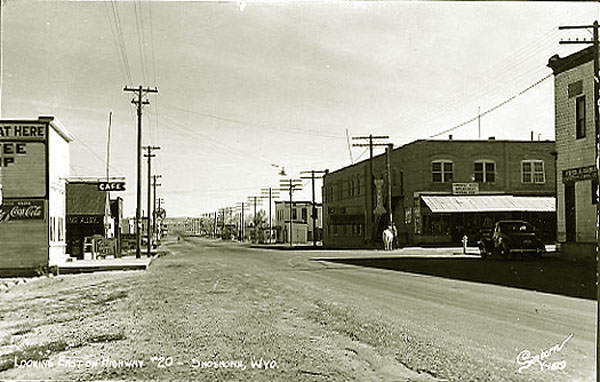
Intersection of 2nd Street with Main, approx. 1939, photo by William P. Sanborn.
In the above scene, the Shawver Hotel is the two story brick building. It was constructed in 1909 by Lewis A. Shawver (1872-1947).
Prior to the fire, the Masonic Hall was down the street above the Williams' Saloon. After the fire, the Eastern Star had to scrounge for a meeting place. For a period of
time they had to meet in the attic of the school. Access was provided by a ladder. After the hotel was built they met for a period of time in the
basement of the hotel. Shawver at one time served as mayor. Shawver also operated a
transfer service to Bonneville. In 1917, the Shoshoni Sate Bank was formed with Shawver as president.
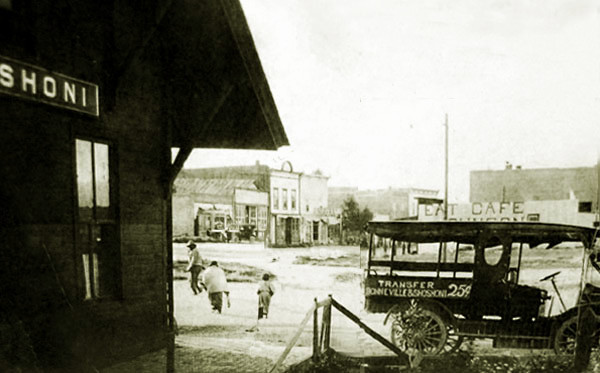
View of Main Street from Depot. Transfer bus to Bonnvevile parked outside. In 1920, Robert F.Fuller took over operation of the
hotel and transfer service.
Besides being a transfer point to Bonneville, stage service was available to Thermopolis and to the mining camps at Copper Mountian. Shoshoni was regarded as the
supply point for Copper Mountain. At one time there were four livery barns,
tbe Star Livery and Feed Barn owned by J. F. Voss, Giesey & Johnson's Feed, Sale Stable on the east side next to the Railroad Well, Morrison & McCoy's Capital Livery, and William Tracy's Livery and Feed Stable (the "Blue Front Livery)."
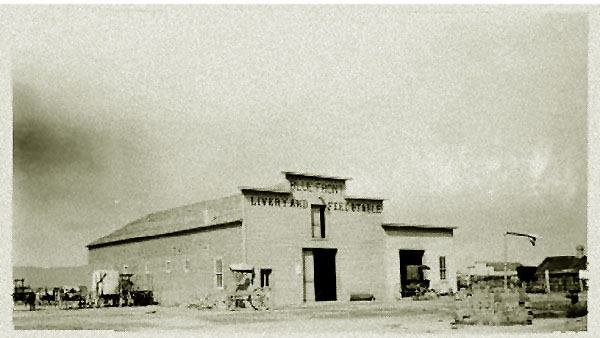
Wm. Tracy's Blue Front Livery, undated.
William Tracy served as mayor in 1918 and 1920. Town Coronor in 1917 and 1921 as Town Marshal.
Perhaps one of the highlights of Tracy's career as Town Marshal was in February of 1921. It will be recalled that gambling continued after the murder of
town attorney Moody. In May of 1921, Fremont County sheriff W. S. Burch conducted a large raid on assorted gambling dens in Shoshoni. Gambling was apparently so open that the Wyoming State Journal referred to
Shoshoni as the "Monte Carlo of Fremont County." Wyoming State Journal, Feb. 5, 1921.
The amount of gambling equipment siezed in the raid was such that the sheriff had to charter half a box car to haul away the
equipment. Among those arrested for conducting gambling games was town marshal William Tracy. Others included
George Heard, Mr. and Mrs. Herman Schrader propriators of Schrader's Pool Hall, John Bray owner of Bray's Pool Hall, and George
Fisher of Fisher's Pioneer soft drink parlor. `
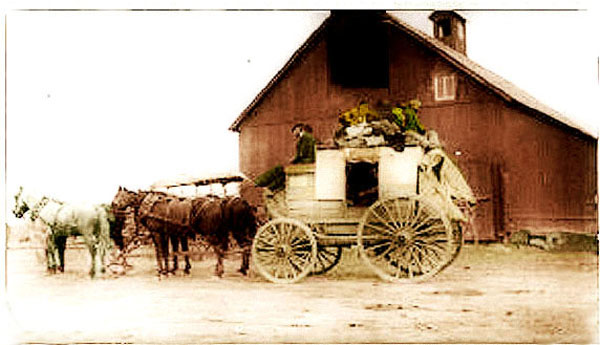
Stage in front of Livery Barn, undated.
On May 29, George C. Heard was killed in a shootout with deputy Fred Northern in the downstairs hallway of the Central Hotel in Shoshoni. Fred was badly wounded from three shots but survived.
George's wounds from five shots including one through the heart were more serious. Two days later, in the early
morning hours of May 31, 1922, two unidentified yeggs broke into the Shoshoni State Bank and blew up the bank's safe and made off with the contents.
An investigation was conducted. During the course of the investigation, it was discovered that prior to his demise, George had been planning
to rob the Poposia Coal Company payroll. He had concealed horses at Poposia and at Sweetwater Rim in order to escape to the Rushton Ranch where a fast car had been concealed for further getaway.
Additionally, it was revealed that George had planned to entice Sheriff Burch into an ambush at Copper Mountain by having someone reveal the existence of a still.
There, Sheriff burch would be assassinated.
Next Page: Shoshoni continued
|





